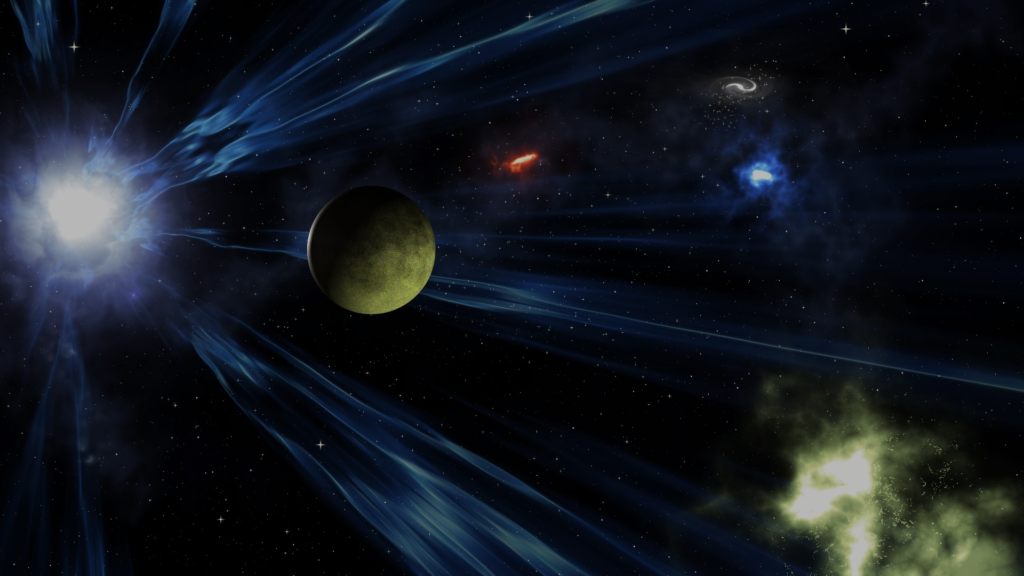## A Journey Through the Milky Way Galaxy: Its Structure and Wonders
Have you ever looked up at the night sky and felt a sense of awe, wondering about the countless stars scattered across the inky blackness? Those twinkling points of light are just a tiny fraction of our incredible home galaxy: the Milky Way. It’s a swirling city of stars, gas, dust, and mysterious dark matter, a cosmic marvel that continues to captivate scientists and stargazers alike. Join us on a breathtaking journey through its structure and wonders!
### 1. The Milky Way’s Spiral Structure: A Celestial Pinwheel
Imagine a giant, flattish spiral pinwheel, with its arms gracefully winding outwards. That’s a simplified picture of the Milky Way. We reside within one of these spiral arms, called the Orion Arm (or Orion Spur), about 26,000 light-years from the galactic center. The spiral arms themselves aren’t rigidly fixed structures; they’re more like density waves, regions where stars and gas are more concentrated. Think of it like a traffic jam on a highway – stars bunch up in the arms as they move around the galaxy’s center.
The galaxy’s central region, or galactic bulge, is a densely packed cluster of older stars, giving it a brighter, more yellowish appearance compared to the younger, bluer stars found predominantly in the spiral arms. Beyond the bulge lies the galactic halo, a vast, spherical region encompassing the entire structure, populated by globular clusters (dense spherical collections of hundreds of thousands of stars) and dark matter – a mysterious substance we’ll explore further.
### 2. Galactic Inhabitants: Stars, Gas, and Dust
The Milky Way is home to an estimated 100 to 400 billion stars! These stars vary drastically in size, mass, temperature, and age. We have red dwarfs, tiny and long-lived; yellow dwarfs like our Sun, with moderate lifespans; and blue giants, massive and short-lived. Interspersed between these stellar inhabitants are vast clouds of gas and dust, the raw materials for new stars. These nebulae, often colorful and breathtaking in images from telescopes like Hubble and James Webb, are stellar nurseries where gravity pulls gas and dust together to ignite the birth of new stars. The Orion Nebula, for example, is a famous example visible even to amateur astronomers.
### 3. The Mysterious Dark Matter: The Galaxy’s Invisible Scaffolding
One of the most intriguing aspects of the Milky Way is the presence of dark matter. We can’t see it directly because it doesn’t interact with light, but we know it’s there due to its gravitational effects on visible matter. Dark matter makes up about 85% of the galaxy’s mass and acts as a gravitational scaffolding, holding the Milky Way together and preventing it from flying apart. Scientists are actively researching the nature of dark matter, a mystery that continues to challenge our understanding of the universe.
### 4. Our Place in the Milky Way: A Cosmic Perspective
Understanding our place within the Milky Way gives us a deeper appreciation for our universe’s vastness. We’re not just a random speck of dust, but part of a larger, interconnected system – a beautiful cosmic dance of stars, gas, and dark matter. By studying the Milky Way, we gain insights into galaxy formation, stellar evolution, and the overall evolution of the universe. Our Sun, and our entire solar system, is constantly orbiting the galactic center, completing one revolution approximately every 230 million years!
### 5. Exploring Further: Your Galactic Adventure
This journey through the Milky Way is just the beginning. There’s so much more to discover, from the supermassive black hole at the galactic center (Sagittarius A*) to the ongoing research on dark matter and the formation of new stars. Grab a pair of binoculars or a telescope and start your own exploration of the night sky. Identify constellations, locate bright stars, and marvel at the beauty of the Milky Way band stretching across the heavens. Share your stargazing experiences and questions in the comments below – let’s explore the universe together!


